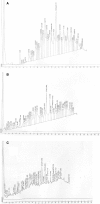Metabolism of waste engine oil by Pseudomonas species
- PMID: 28330168
- PMCID: PMC4826381
- DOI: 10.1007/s13205-016-0419-5
Metabolism of waste engine oil by Pseudomonas species
Abstract
Two bacterial strains phylogenetically identified as Pseudomonas aeruginosa strains RM1 and SK1 displayed extensive degradation ability on waste engine oil (SAE 40W) in batch cultures. Spectrophotometric analysis revealed the presence of various heavy metals such as lead, chromium and nickel in the waste engine oil. The rate of degradation of waste engine oil by the isolates, for the first 12 days and the last 9 days were 66.3, 31.6 mg l-1 day-1 and 69.6, 40.0 mg l-1 day-1 for strains RM1 and SK1, respectively. Gas chromatographic (GC) analyses of residual waste engine oil, revealed that 66.58, 89.06 % and 63.40, 90.75 % of the initial concentration of the waste engine oil were degraded by strains RM1 and SK1 within 12 and 21 days. GC fingerprints of the waste engine oil after 12 days of incubation of strains RM1 and SK1 showed total disappearance of C15, C23, C24, C25 and C26 hydrocarbon fractions as well as drastic reductions of C13, C14, C16 and PAHs fractions such as C19-anthracene and C22-pyrene. At the end of 21 days incubation, total disappearance of C17-pristane, C22-pyrene, one of the C19-anthracene and significant reduction of C18-phytane (97.2 %, strain RM1; 95.1 %, strain SK1) fractions were observed. In addition, <10 % of Day 0 values of medium fraction ranges C13, and C16 were discernible after 21 days. This study has established the potentials of P. aeruginosa strains RM1 and SK1 in the degradation of aliphatic, aromatic and branched alkane components of waste engine oils.
Keywords: Biodegradation; Phytane; Pristane; Pseudomonas aeruginosa; Waste engine oil.
Conflict of interest statement
The author declares that he has no conflict of interest in the publication.
Figures



Similar articles
-
Degradation of crude oil by Acinetobacter calcoaceticus and Alcaligenes odorans.J Appl Bacteriol. 1996 Oct;81(4):355-62. doi: 10.1111/j.1365-2672.1996.tb03519.x. J Appl Bacteriol. 1996. PMID: 8896350
-
Biodegradation Study of Used Engine Oil by Free and Immobilized Cells of the Pseudomonas oleovorans Strain NMA and Their Growth Kinetics.ACS Omega. 2024 Dec 31;10(1):541-549. doi: 10.1021/acsomega.4c06964. eCollection 2025 Jan 14. ACS Omega. 2024. PMID: 39829463 Free PMC article.
-
Differential degradation of crude oil (Bonny Light) by four Pseudomonas strains.J Environ Sci (China). 2009;21(2):243-8. doi: 10.1016/s1001-0742(08)62258-5. J Environ Sci (China). 2009. PMID: 19402429
-
Microbial desalination cell for enhanced biodegradation of waste engine oil using a novel bacterial strain Bacillus subtilis moh3.Environ Technol. 2014 Sep-Oct;35(17-20):2194-203. doi: 10.1080/09593330.2014.896951. Environ Technol. 2014. PMID: 25145172
-
Prestige oil spill. III. Fate of a heavy oil in the marine environment.Environ Sci Technol. 2007 May 1;41(9):3075-82. doi: 10.1021/es0629559. Environ Sci Technol. 2007. PMID: 17539507
Cited by
-
Bioremediation of Oil-Contaminated Soil of the Republic of Kazakhstan Using a New Biopreparation.Microorganisms. 2023 Feb 18;11(2):522. doi: 10.3390/microorganisms11020522. Microorganisms. 2023. PMID: 36838488 Free PMC article.
-
Efficient biodegradation of petroleum n-alkanes and polycyclic aromatic hydrocarbons by polyextremophilic Pseudomonas aeruginosa san ai with multidegradative capacity.RSC Adv. 2020 Apr 7;10(24):14060-14070. doi: 10.1039/c9ra10371f. eCollection 2020 Apr 6. RSC Adv. 2020. PMID: 35498501 Free PMC article.
-
Biostimulation potentials of corn steep liquor in enhanced hydrocarbon degradation in chronically polluted soil.3 Biotech. 2019 Feb;9(2):46. doi: 10.1007/s13205-019-1580-4. Epub 2019 Jan 23. 3 Biotech. 2019. PMID: 30729070 Free PMC article.
-
Biodegradation of used engine oil by novel strains of Ochrobactrum anthropi HM-1 and Citrobacter freundii HM-2 isolated from oil-contaminated soil.3 Biotech. 2016 Dec;6(2):226. doi: 10.1007/s13205-016-0540-5. Epub 2016 Oct 19. 3 Biotech. 2016. PMID: 28330298 Free PMC article.
-
Metagenomic insights into effects of spent engine oil perturbation on the microbial community composition and function in a tropical agricultural soil.Environ Sci Pollut Res Int. 2017 Mar;24(8):7139-7159. doi: 10.1007/s11356-017-8364-3. Epub 2017 Jan 16. Environ Sci Pollut Res Int. 2017. PMID: 28093673
References
-
- Adebusoye SA, Ilori MO, Amund OO, Teniola OO, Olatope SO. Microbial degradation of petroleum in a polluted tropical stream. World J Microbiol Biotechnol. 2007;23:1149–1159. doi: 10.1007/s11274-007-9345-3. - DOI
-
- Adelowo OO, Alagbe SO, Ayandele AA. Time-dependent stability of used engine oil degradation by cultures of Pseudomonas fragi and Achromobacter aerogenes. Afr J Biotechnol. 2006;5:2476–2479.
-
- Akoachere JF, Akanji TN, Yongabi FN, Nkwelang G, Ndip RN. Lubricating oil degrading bacteria in soil from filling stations and auto-mechanic workshop in Buea, Cameroun. Occurrence and characteristics of isolates. Afr J Biotechnol. 2008;7:170–176.
-
- Bagherzadeh-Namazi A, Shojaosadati SA, Hashemi-Najafabadi S. Biodegradation of used engine oil using mixed and isolated cultures. Int J Environ Res. 2008;2:431–440.
LinkOut - more resources
Full Text Sources
Other Literature Sources
Molecular Biology Databases
Miscellaneous

